by Rosemarie Arbur, Oregon, US |
by Rosemarie Arbur, Oregon, US |
| Last summer, I watched a Dileptus eat a Litonotus (also a predatory ciliate) and in the fall shared my experience in Micscape(1). As long as that bloom of large ciliates(2) flourished in my jar of water, I was entranced. I saw one fat, lethargic, unmistakable Paradileptus robustus, its grotesque shape offset by its transparent clarity. And I saw many Cyclidium—small, filter-feeding ciliates one of which seemed invariably to be present whenever I was observing a larger, less common critter. The Cyclidium would remain motionless, then—zip!—it would vanish and reappear in a new location. Cyclidium achieves this by bouncing or leaping with its stiffer cilia, rather like Halteria. It doesn't usually swim. Mostly, it's impossible to be sure that the Cyclidium here is the same one that had been till a half-second before over there. They're very small—about 25µm long—and all of them look like this: |
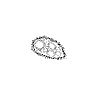 |
|
While insisting on the truth of the preceding sentence, I admit that, using oil immersion and far more patience than I normally possess, I have also seen Cyclidium look like this: |
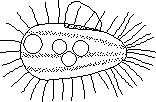 |
|
The little loop—where it looks as if two cilia are joined—is Cyclidium's undulating membrane. Its cytostome is near the midpoint of its body, and this membrane directs bacteria and other appropriately sized particles into it. The 100× objective lets one see that the tiny, apparently motionless ciliate can and does create some impressive feeding vortices in the water around it. Yet my painstaking drawing of this 25-µm-long critter lacks the anterior "cap" and single, 15-µm-long-all-by-itself caudal cilium that Jahn gives it (below) in How to Know the Protozoa |
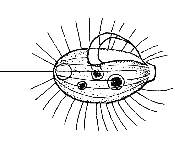 |
| —for even with oil immersion and heroic
patience I didn't see them on any of the three individuals I observed for
my sketch. I did see longer, more active cilia up front, and between
then and now—after I finished the drawing and learned to see better—I've
noticed the cap and caudal cilium on quite a few of the Cyclidium
I've encountered.
Here is another representation, of a 27-µm-long Cyclidium seen with my 40× objective. I think it captures something essential, something that belongs to the organism itself and not just to the strange little onlooker I've seen off to the side of larger, more interesting protists. |
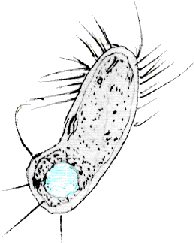 |
|
Besides letting you see Cyclidium pretty well and hinting at the indeterminacy of what we see through our microscopes(3), these illustrations do lead to the rest of this article, which climaxes with a sudden, unexpected, yet (quite possibly because it was unexpected) authentic view of what "the literature" on Dileptus did not prepare me for. Here's my second adventure with that rapacious carnivore. |
|
As usual, it seems, there's a big bubble in the center of my slide; soon, a 600-µm Dileptus sets up between it and some algae to hunt. |
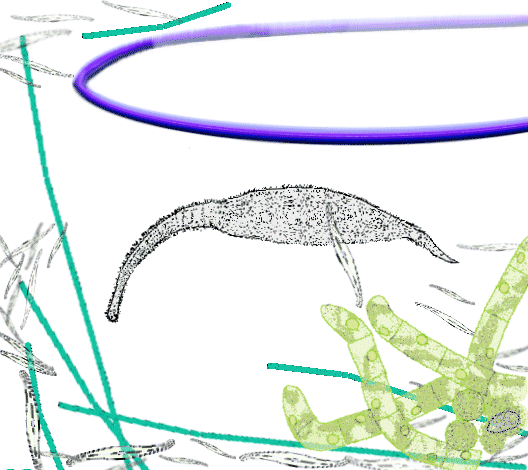 |
|
Dileptus hunts by swinging its neck in long arcs. If the neck encounters prey, it sweeps it toward and into the cytostome that opens where the neck and the body join. Not encountering prey, the neck continues to sweep . . . |
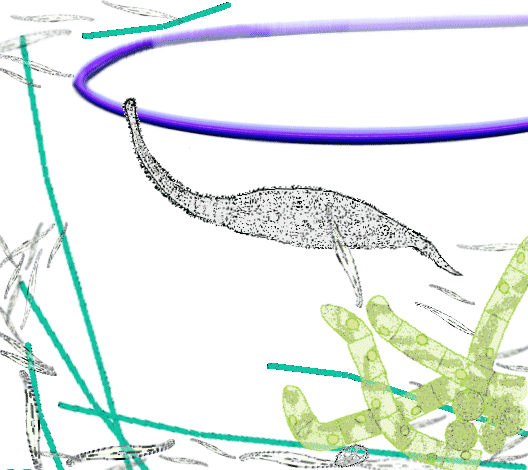 |
|
A second Dileptus appears and heads toward the bubble; it rubs against the other, but neither responds to the contact. |
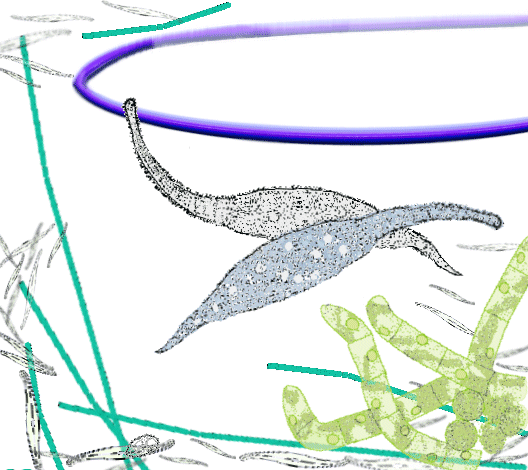 |
|
The second Dileptus slithers past the first, gets closer to the bubble, and begins its hunting. |
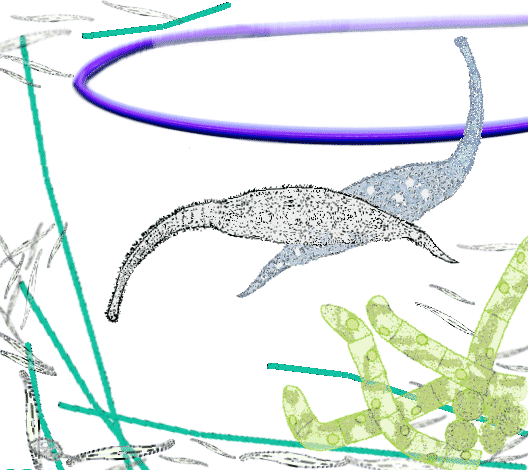 |
|
They're quite a sight. Finding either one of these critters would constitute a definite Successful Day at the Microscope. Finding both was awesome. They're big—holding my slide to the window light later, I actually saw one of them waving its neck! And having seen another Dileptus capture and eat a 65-µm Litonotus—having seen, not just known it was a "carnivore" and "ate other organisms"—charged my observing of these two predators with palpable tension; for I knew that soon something violent, astonishing, and real was going to happen. All I needed to do was pay attention. |
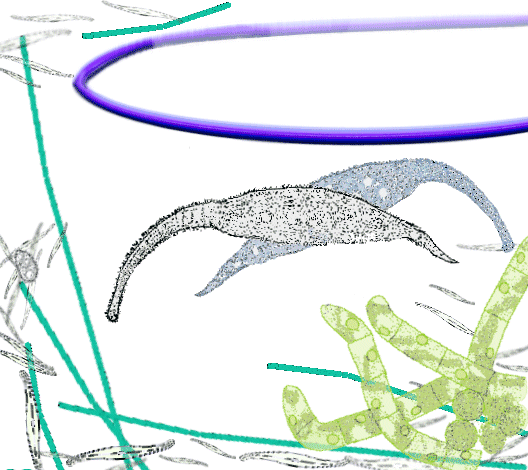 |
|
Meanwhile, I couldn't help wondering at the "companionship" here. Being in intermittent contact, these two Dileptus were at least as "aware" of one another as my first Dileptus had been of the Litonotus it touched, killed, and ingested. How did these carnivores "know enough" not to try to eat each other? Did each prove immune to the other's bio-weaponry? Or did their chemo-receptors fail to identify another Dileptus as prey?(4) |
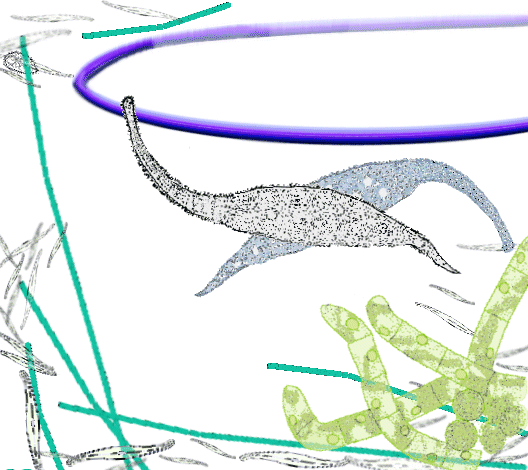 |
|
As the Dileptus' necks sweep up and down, they present almost an optical illusion. These illustrations show the necks between edge-on and full (flat) view. Really, however, their necks are nearly invisible edge-on; they're ribbon-like, very thin, and with sometimes-visible, wavery edges. Paying extreme attention, one is rewarded by seeing the cilia, longer and finer than I show here, but only momentarily: the neck moves, one adjusts focus, and the cilia are gone. |
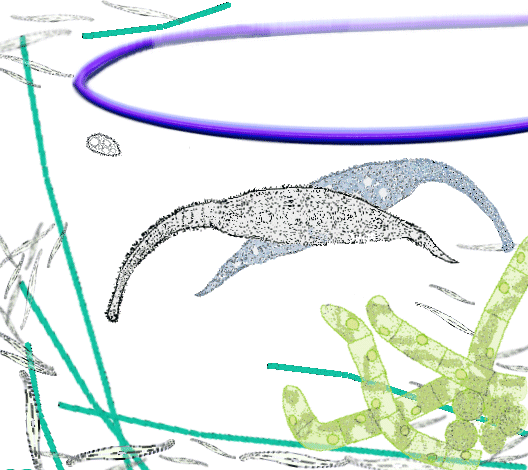 |
|
Dileptus' neck also contains myonemes, contractile fibers or threads or filaments that determine its thickness and length and shape. Spirostomum's myonemes are the world's fastest, Lacrymaria olor's are probably the stretchiest, and the one inside Vorticella's stalk may be the most familiar, but the myonemes in Dileptus' neck are impressive and, once identified, easy to observe. They're the striations in the first Dileptus' neck. |
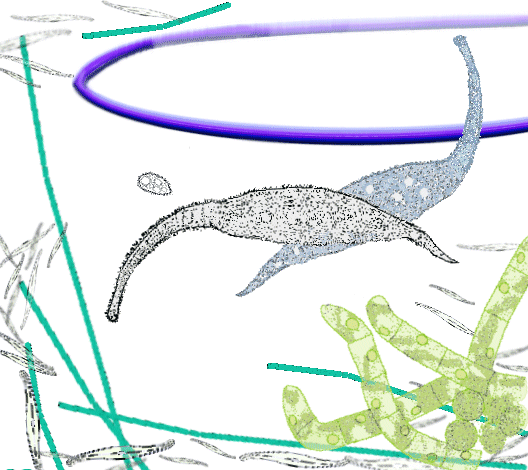 |
|
Making these observations, I've been noticing a Cyclidium swimming (not hopping) along the edge of the bubble. Either it's moving leisurely or I'm watching in slow-motion, seeing the little ciliate move closer and closer to the large predators, move closer and closer to its death, I'm pretty sure. Just when I'd given up hope for it—reconciled to the violence about to happen and eager to witness it—I realized that the little Cyclidium had slipped between deadly swings of Dileptus' neck. It came even with Dileptus' body, and the neck never even touched it! By some accident, the little critter had escaped. |
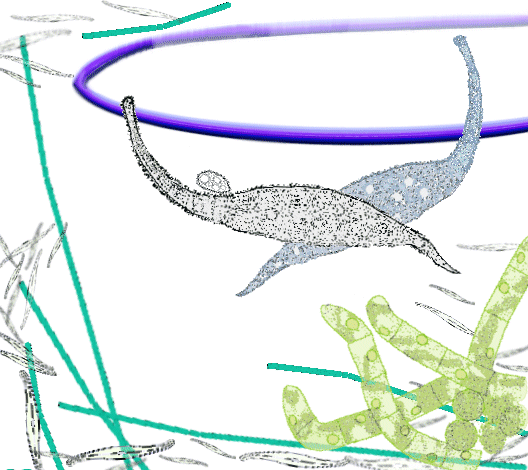 |
|
Then Dileptus' cytostome appears, black and just large enough. A sort of lip materializes in front of the Cyclidium, and the little swimmer is smoothly and swiftly sucked inside. It wasn't even big enough to occasion much of a lump. |
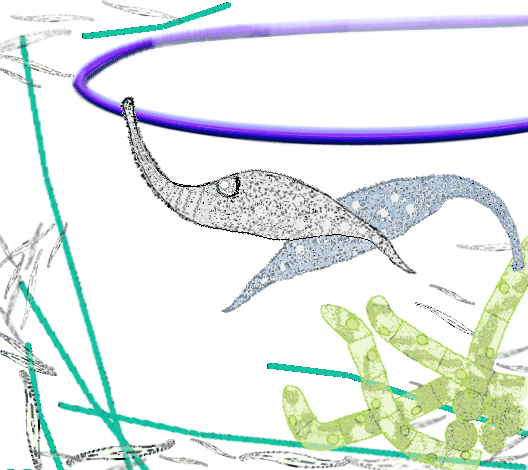 |
|
The two Dileptus continue their hunting. Another Cyclidium appears, having hopped in from somewhere. I've had another Great Day at the Microscope, and I've learned that Dileptus can ingest its prey without any help at all from its long, strong, wonderful neck. |
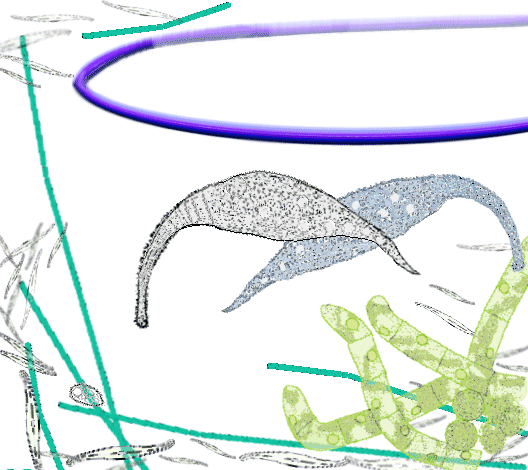 |
| Notes
1 "Dileptus at Dinnertime" appeared in Nov 2000. 2 These bottom feeders came from a small, stream-fed, dammed pond, but they didn't appear until 2½ weeks after I brought them home in early August. 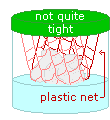 I had taken about 3 oz (total volume) of soil—some damp, from about 4"
above the shoreline; some wet, from where water met land; and some from
the bottom about 4" into the pond—and made an infusion by wrapping the
soil/mud in two tissues and suspending it so the tissues maintained contact
with boiled well water. (In 3 days migration from soil to water is noticeable.)
I threw out the mud after 5 days but kept the water, in which a surprising
diversity of protists succeeded one another for nearly a month.
I had taken about 3 oz (total volume) of soil—some damp, from about 4"
above the shoreline; some wet, from where water met land; and some from
the bottom about 4" into the pond—and made an infusion by wrapping the
soil/mud in two tissues and suspending it so the tissues maintained contact
with boiled well water. (In 3 days migration from soil to water is noticeable.)
I threw out the mud after 5 days but kept the water, in which a surprising
diversity of protists succeeded one another for nearly a month.
3 For a demonstration of "objective" indeterminacy, see Bill Ells's article, "Optical Illusions and the Microscope," Dec 2000. 4 Dileptus' hunting is complex. It injects its prey with toxicysts, from the vicinity of its mouth, which by paralyzing make the prey easier to ingest. (When I watched Dileptus kill and eat Litonotus, however, I saw Litonotus die—its pellicle ruptured when Dileptus' neck touched it—a good 100 µm from Dileptus' mouth.) The "companionship" I noticed between these two Dileptus is more likely the result of chemo-receptivity: along with Amoeba proteus, Peranema, Didinium nasutum, and Lacrymaria olor, Dileptus anser has been shown to select its prey by means of chemical attractants and repellants (Johanna Laybourn-Parry, A Functional Biology of Free-Living Protozoa, 1984, pp. 41, 54). Rather undramatically, neither could recognize the other as a potential meal. |
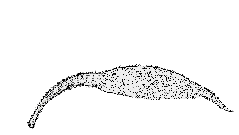 |
Comments to the author Rosemarie
Arbur are welcomed.
Microscopy UK Front Page
Micscape Magazine
Article Library
Please report any Web problems or offer
general comments to the Micscape
Editor,
via the contact on current Micscape
Index.
Micscape is the on-line monthly magazine
of the Microscopy UK web
site at Microscopy-UK